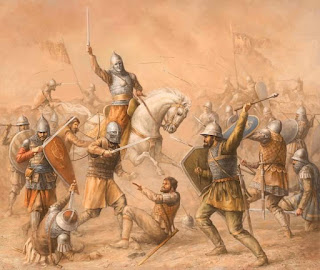Roman troops defeat the Rus' at Arcadiopolis in March 970 AD
In early 970, the Rus' army, with large contingents of Bulgarians, Pechenegs, and Magyars, crossed the Balkan mountains and headed south. The Rus' stormed the city of Philippopolis (now Plovdiv) and, according to Leo the Deacon, impaled 20,000 of its surviving inhabitants. Skleros, with an army of 10,000–12,000 men, met the advancing Rus' near Arcadiopolis (now Luleburgaz) in early spring of the year 970.
The Eastern Roman general, whose army was considerably outnumbered, used a mock retreat to draw the Pecheneg contingent away from the main army in a prepared ambush. The main Rus' army panicked and fled, suffering heavy casualties at the hands of the pursuing Imperials. The Rus withdrew north of the Balkan range, giving to the Emperor Tzimiskes time to deal with internal disturbances and muster his own forces for the new campaign to come.
After being busy suppressing the Bardas Phokas revolt throughout 970, Emperor Tzimiskes prepared his forces in early 971 for a campaign against the Rus', moving his troops from Asia to Thrace and gathering supplies and siege equipment. The imperial fleet accompanied the expedition, in charge of transporting troops to make a landing in the enemy's rear and cut off their retreat across the Danube.
The Emperor chose Easter of the year 971 to make his move, and it took the Rus completely by surprise: the Balkan mountain passes had been left unprotected, either because the Rus were busy suppressing the Bulgarian revolts or perhaps (as suggested by A.D. Stokes) because a peace agreement that had been concluded after the Battle of Arcadiopolis made them complacent.
The Eastern Roman army, led by Emperor John Tzimiskes in person and numbering 30,000 to 40,000 men, advanced rapidly and reached Preslav safely. The Rus' army was defeated in battle before the city walls, and the Imperials proceeded to lay siege to the city. The Rus and Bulgarian garrison under the command of the nobleman Sphangel put up a determined resistance, but the city was stormed on April 13.
Among the captives were Boris II and his family, who were brought to Constantinople along with the imperial regalia of Bulgaria. The main Rus' force, under Sviatoslav, withdrew before the Imperial army towards Dorostolon on the Danube. As Svyatoslav feared a Bulgarian uprising, he had 300 Bulgarian noblemen executed and many others imprisoned.
The imperial army advanced unhindered; the Bulgarian garrisons of the various forts and fortresses along the way surrendered peacefully. As the Eastern Romans approached Dorostolon, they encountered the Rus' army, which had been deployed in a field in front of the city, ready for battle. After a long and bitter fight, the imperials won thanks to the cataphracts of Juan Tzimices. The Rus quickly broke ranks and fled inside the fortress. The subsequent siege of Dorostolon lasted three months, during which the Imperials blockaded the city by land and sea and the Rus' attempted various sorties. Three pitched battles were fought, all of which ended in Roman victories. After the final and particularly savage battle at the end of July, the Rus' were forced to capitulate. According to Imperial chroniclers, only 22,000 of an original army of 60,000 men remained at this time.
Tzimiskes and Sviatoslav met and agreed on a peace treaty: the Rus' army was allowed to depart, leaving their captives behind, and their trading rights were reaffirmed in return for an oath never to attack Imperial territory again. Sviatoslav would not long survive the peace agreement, as he was killed on his way home in a Pecheneg ambush on the Dnieper River. John Tzimisces returned in triumph to Constantinople, where the Emperor entered through the Golden Gate behind a chariot bearing an icon of the Virgin Mary as well as the Bulgarian regalia, with Boris and his family trailing behind the Emperor. When the procession reached the Forum of Constantine, Boris was publicly stripped of the imperial insignia from him, and in the church of Hagia Sophia, the Bulgarian crown was dedicated to God.
-Illustration by Mateusz Przeklasa for ArtStation
~Marcius











Comments
Post a Comment